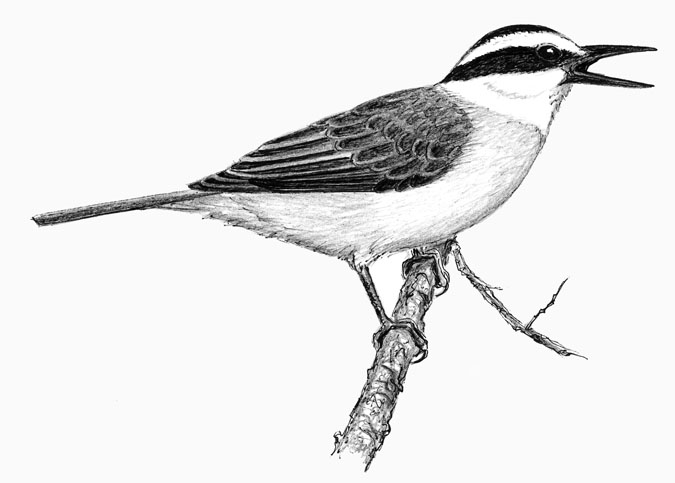
Dear Bird Folks,
I’ve just returned from a trip to Bermuda where I saw several new birds, including some rather noisy birds called “kiskadees.” My books say kiskadees live in southern Texas and Mexico. How did they end up in Bermuda?
– Todd, Newport News, VA
Not Bermuda, Todd,
I hate thinking about Bermuda. My wife and I visited that little island about thirty years ago and it still gives me nightmares. No, the nightmares have nothing to do with the crazy tourists on motor scooters or seeing grown men wearing those ridiculous shorts. My problem has to do with whom I went there with. Somehow I thought it would be fun to include my extended family on the trip. My wife and I flew to romantic Bermuda with all my in-laws, plus my mother (my old man had enough sense to stay home). It gets worse. For reasons only a Freudian could explain, I invited my mother to share a hotel room with my wife and me. Really. Don’t get me wrong, my mother is a sweet, elderly lady, but there’s a lot of sweet, elderly ladies I don’t need to share a hotel room with. Fortunately, my mother doesn’t snore, but there was another problem. Mom likes to talk…and talk and talk and talk. For example: Every night she would go to bed at 11:00, fall asleep at 11:20, but didn’t stop talking for another two hours. I know that sounds impossible, but it’s basically true. Thanks for bring up Bermuda, Todd.
Speaking of nonstop talking, that is also the trademark of the colorful Great Kiskadee. Anyone who has visited Bermuda has most likely seen one of these bright yellow and black birds, or has at least heard one. Kiskadees are so proud of their name they never stop saying it. Kis-ka-dee, kis-ka-dee, kis-ka-dee can be heard throughout the island anytime of year. Many Bermudians complain about all the noise, but I liked it. It helped drown out the sound of their famous bagpipes, as well as somebody’s constant talking.
Kiskadees are freaks in the bird world. They have the lungs of a jay, the diet of a crow and the hunting skills of shrikes and kingfishers. Ornithologists tell us that they are flycatchers, but the truth is the birds aren’t all that fond of flies. They’d rather eat beetles, spiders, lizards, snails, fish and occasionally fruit for roughage. And their hunting methods are equally diverse. Sometimes they’ll fly off a branch to catch passing bees, or swoop into a bush to snag sleeping lizards or dive right into a pond to catch any small fish that have carelessly gotten too close to the surface. Even dogs don’t bother these birds. They’ll readily steal dog food out of any unguarded bowls. The only things kiskadees seem to be afraid of are snakes, especially coral snakes. I couldn’t agree with them more.
As you mentioned, Todd, kiskadees are normally found in Texas and Mexico. In fact, they actually live as far south as Argentina, yet they have no migratory habits. All they need is a snake-free place to nest and a bowl of dog food and they’ll happily stay in the same location forever. Because of their sedentary habits, there is little chance kiskadees found their way to the Island of Bermuda on their own. So how did they get there? One theory suggests that a family of kiskadees disembarked from a Carnival cruise ship, which was docked in Hamilton Harbor, and refused to get back on board because the ship’s buffet had run out of bees, lizards and no dog food. The more likely scenario has to do with a group of boneheads who, in 1957, captured 200 kiskadees in Trinidad and imported them to Bermuda. Why would they do that, you ask. They thought the birds would help control the anoles. Anoles are small, harmless and actually beneficial lizards, which makes the idea of importing birds to control them even more ridiculous. According to the story, some of the locals wanted to get rid of the anoles because the little lizards ate too many ladybirds. (Ladybirds are what the whacky Brits call ladybugs. Don’t ask me why.) As is usually the case with most of these stupid ideas, the plan backfired. Instead of eating the anoles, the omnivorous kiskadees ate the young of native songbirds, devoured ripening fruit and caused the extinction of “singers,” an endemic species of cicada. Today, kiskadees are a problem in Bermuda and it’s all because some idiots were in love with ladybirds…and none of them were LBJ.
On a different topic: For the past few years there’s been a noticeable lack of calls from people complaining about raccoons trashing their bird feeders. An assortment of illnesses has apparently caused a dip in the local raccoon population. It’s been a nice break, but change is in the air. Since the middle of summer we’ve had a steady stream of people coming in with twisted and mangled bird feeders. Nearly 100% of the upset customers readily blame the problem on the gray squirrels, their universal whipping boys. But if a feeder is found on the ground or are all disheveled, the perpetrators are most certainly raccoons. (So get off the squirrel’s back.) The best way to protect your feeders is to mount them all on a pole that is protected by a specifically designed raccoon baffle. Or, since raccoons are nocturnal, simply take your feeders in at night. If you don’t like either of those ideas, you could also open your window and play bagpipe music all night. That would certainly keep the nocturnal creatures away, but I think I’d rather have the raccoons.